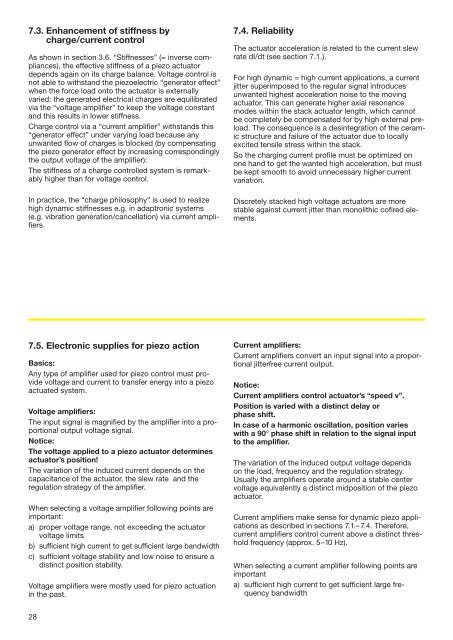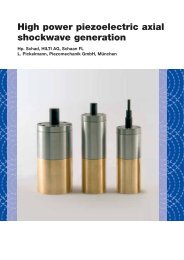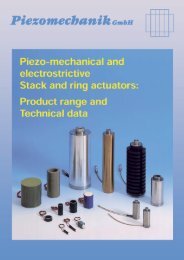231575 Piezo-Mechanics GB
231575 Piezo-Mechanics GB
231575 Piezo-Mechanics GB
Create successful ePaper yourself
Turn your PDF publications into a flip-book with our unique Google optimized e-Paper software.
7.3. Enhancement of stiffness bycharge/current controlAs shown in section 3.6. “Stiffnesses” (= inverse compliances),the effective stiffness of a piezo actuatordepends again on its charge balance. Voltage control isnot able to withstand the piezoelectric “generator effect”when the force load onto the actuator is externallyvaried: the generated electrical charges are equilibratedvia the “voltage amplifier” to keep the voltage constantand this results in lower stiffness.Charge control via a “current amplifier” withstands this“generator effect” under varying load because anyunwanted flow of charges is blocked (by compensatingthe piezo generator effect by increasing correspondinglythe output voltage of the amplifier):The stiffness of a charge controlled system is remarkablyhigher than for voltage control.In practice, the “charge philosophy” is used to realizehigh dynamic stiffnesses e.g. in adaptronic systems(e.g. vibration generation/cancellation) via current amplifiers.7.4. ReliabilityThe actuator acceleration is related to the current slewrate dI/dt (see section 7.1.).For high dynamic = high current applications, a currentjitter superimposed to the regular signal introducesunwanted highest acceleration noise to the movingactuator. This can generate higher axial resonancemodes within the stack actuator length, which cannotbe completely be compensated for by high external preload.The consequence is a desintegration of the ceramicstructure and failure of the actuator due to locallyexcited tensile stress within the stack.So the charging current profile must be optimized onone hand to get the wanted high acceleration, but mustbe kept smooth to avoid unnecessary higher currentvariation.Discretely stacked high voltage actuators are morestable against current jitter than monolithic cofired elements.7.5. Electronic supplies for piezo actionBasics:Any type of amplifier used for piezo control must providevoltage and current to transfer energy into a piezoactuated system.Voltage amplifiers:The input signal is magnified by the amplifier into a proportionaloutput voltage signal.Notice:The voltage applied to a piezo actuator determinesactuator’s position!The variation of the induced current depends on thecapacitance of the actuator, the slew rate and theregulation strategy of the amplifier.When selecting a voltage amplifier following points areimportant:a) proper voltage range, not exceeding the actuatorvoltage limitsb) sufficient high current to get sufficient large bandwidthc) sufficient voltage stability and low noise to ensure adistinct position stability.Voltage amplifiers were mostly used for piezo actuationin the past.Current amplifiers:Current amplifiers convert an input signal into a proportionaljitterfree current output.Notice:Current amplifiers control actuator’s “speed v”.Position is varied with a distinct delay orphase shift.In case of a harmonic oscillation, position varieswith a 90° phase shift in relation to the signal inputto the amplifier.The variation of the induced output voltage dependson the load, frequency and the regulation strategy.Usually the amplifiers operate around a stable centervoltage equivalently a distinct midposition of the piezoactuator.Current amplifiers make sense for dynamic piezo applicationsas described in sections 7.1.–7.4. Therefore,current amplifiers control current above a distinct thresholdfrequency (approx. 5–10 Hz).When selecting a current amplifier following points areimportanta) sufficient high current to get sufficient large frequencybandwidth28





